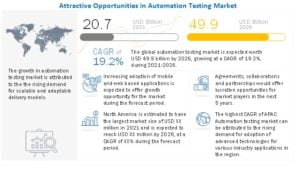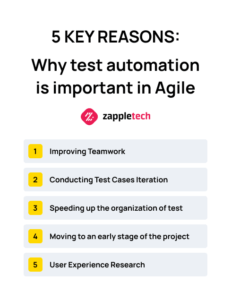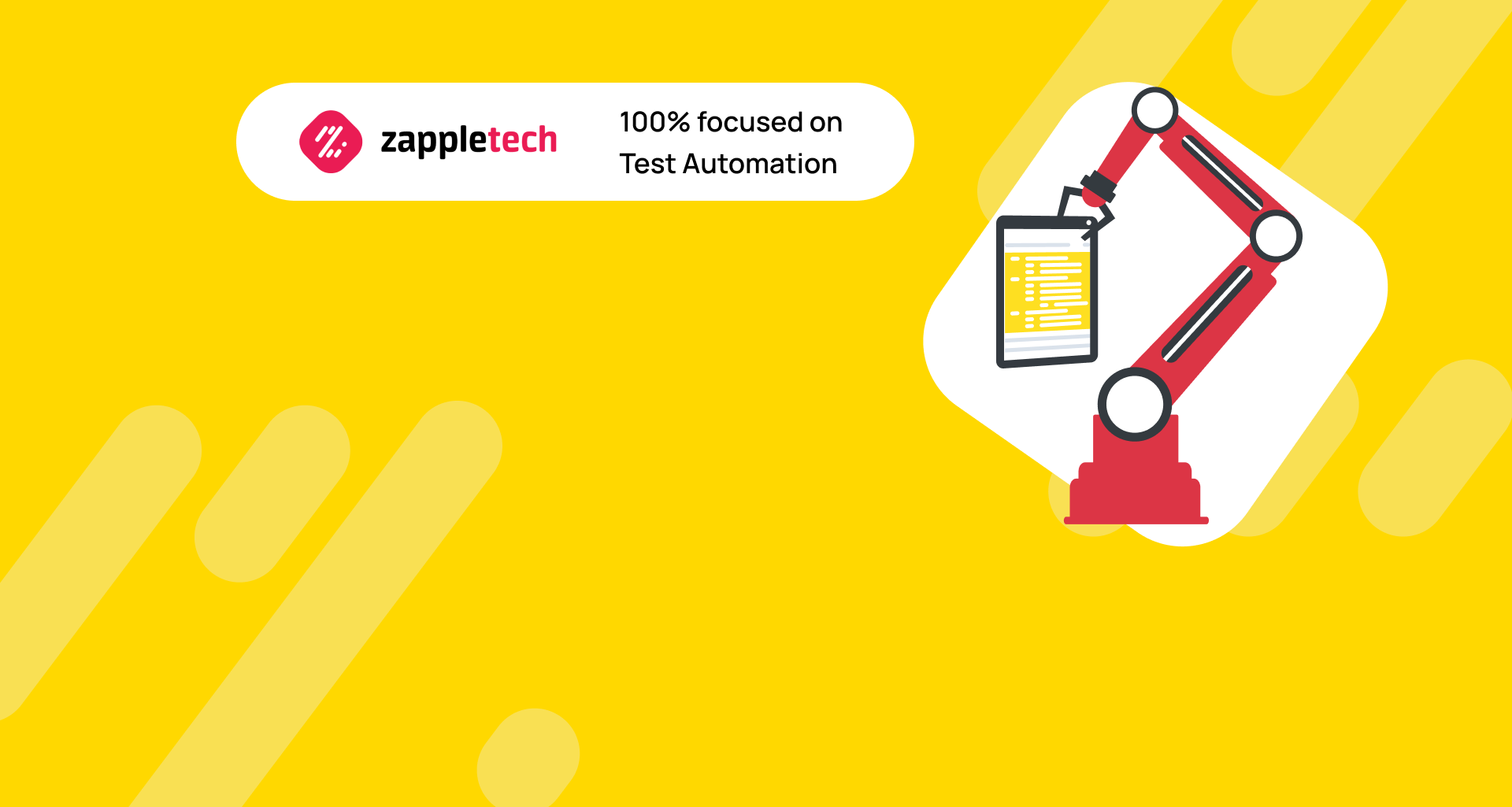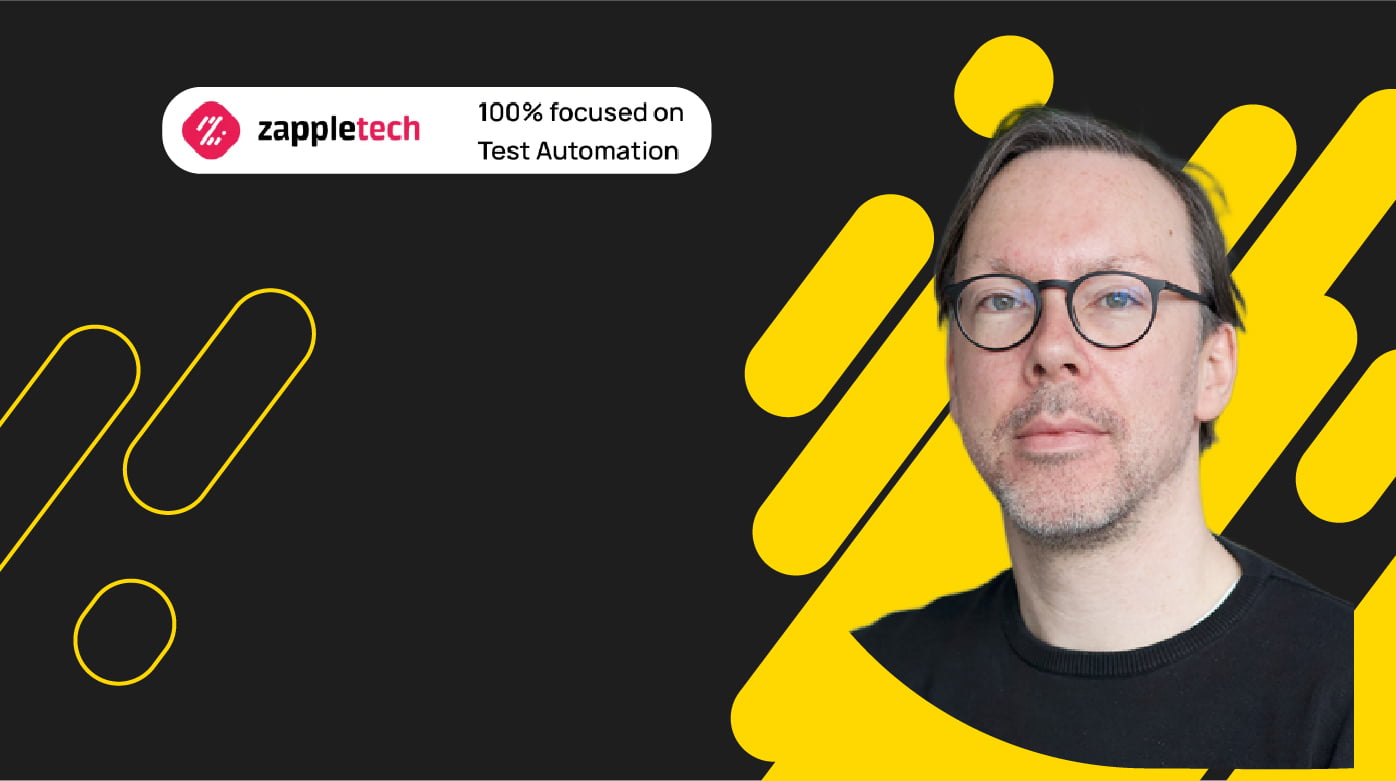If you are interested in the future of automation testing, you probably know that the tools are constantly improving and acquiring new functions. According to the forecasts of business analysts, the QA market will reach $28.8 billion in 2024. As we remember, initially, programmers were forced to distract from the coding process to solve routine tasks. The first testing groups appeared at the beginning of the 2000s. Their main job was finding bugs at all stages, reporting, and sending reports to developers. Now the mechanism has undergone several significant changes and lost almost all past features.
The experts from the ZappleTech team have gathered and analyzed key insights to share their predictions on the future of QA automation. If you are keen on the future of automation testing, these predictions will offer valuable guidance. The ZappleTech team foresees that the integration of AI and machine learning will continue to enhance testing processes, minimizing the need for human intervention and boosting overall efficiency. Continuous testing and DevOps practices are also expected to gain even more traction, leading to faster delivery cycles and higher quality software.
In addition to these technological advancements, the future of automation testing will likely see a significant shift towards cloud-based testing environments. Cloud testing allows for greater scalability, flexibility, and cost-efficiency, making it easier for teams to conduct extensive testing across multiple platforms and devices without the need for physical infrastructure. This trend is expected to accelerate as businesses increasingly adopt cloud technologies to support their development and testing operations.
Furthermore, the rise of no-code and low-code testing tools is set to democratize the testing landscape, empowering non-technical team members to take an active role in the QA process. This shift will foster more collaborative environments, where cross-functional teams work together with greater ease. As cyber threats continue to escalate, security testing will become increasingly vital, with a growing focus on safeguarding sensitive data.
Another key aspect of the future of automation testing is the increasing importance of performance testing. As users demand faster, more responsive applications, businesses must ensure that their software can handle high traffic volumes and complex workloads without compromising performance. Automation tools that specialize in performance testing will play a crucial role in meeting these demands, helping companies deliver robust, reliable applications to their users.
The future of automation testing is not only about the advancements in tools and technology but also about cultivating a mindset that emphasizes quality and continuous improvement. Testers and developers will need to adopt a more holistic approach to quality assurance, one that considers not just the functional aspects of software but also its performance, security, and user experience. By staying abreast of these trends and adapting to new developments, businesses can maintain their competitive edge in a rapidly evolving market. The future of automation testing holds great promise, and those who embrace these changes will be well-positioned for success.
Finally, as automation testing evolves, the role of the QA engineer will also transform. Instead of solely focusing on manual testing tasks, QA professionals will increasingly take on strategic roles, overseeing the implementation of automation frameworks, analyzing test data, and ensuring that testing aligns with broader business objectives. This shift will require continuous learning and skill development, as QA engineers become integral to driving innovation and quality within their organizations. The future of automation testing is an exciting frontier, where technology, collaboration, and strategic thinking come together to create a more efficient, effective, and innovative approach to quality assurance.

Table of Contents
A little QA history
The beginning of the 80s is considered the starting point in the emergence of testing as an independent process. At that time, the Waterfall model was actively developing, which nowadays has become a classic and sunk into oblivion. Of course, the QA process was rigidly tied to the current methodology, so its efficiency was practically equal to zero. The nastiest mistakes appeared at the end of development. Imagine how problematic it was to make changes to an almost finished product.
As we look toward the future of automation testing, it’s essential to recognize the significant strides QA has made since those early days. Back in the 80s, testing was a cumbersome and reactive process, often leading to significant setbacks late in the development cycle. The inefficiency stemmed from the fact that the Waterfall model did not allow for continuous testing or iterative improvements. Instead, quality assurance was an afterthought, resulting in the discovery of critical bugs and errors only after substantial time and resources had already been invested.
Today, the future of automation testing promises a more proactive and integrated approach. Modern methodologies like Agile and DevOps emphasize continuous testing throughout the development lifecycle, ensuring that issues are identified and resolved much earlier. This evolution highlights the shift from a reactive to a proactive QA process, significantly enhancing the overall efficiency and effectiveness of software development.
Furthermore, with advancements in AI and machine learning, the future of automation testing is set to become even more sophisticated. These technologies enable smarter test generation, faster execution, and more accurate bug detection, allowing teams to focus on more complex and creative aspects of development. This progress marks a stark contrast to the manual, labor-intensive methods of the past and underscores the ongoing transformation in the QA landscape
First experiments
After 1990, special tools appeared in QA that caused discomfort instead of simplifying testing. Their functionality was strictly limited and rarely matched the assigned tasks. This decade was a time for experiments with new development models and QA methodologies like Scrum, RAD, or XP. These initial attempts laid the groundwork for the future of automation testing, even though they often fell short of expectations. The lessons learned from these early experiments were crucial in shaping the more sophisticated and effective automation tools we rely on today.
As the future of automation testing continues to evolve, these early experiments serve as a reminder of the importance of innovation and adaptability in the field of quality assurance. The experimentation phase of the 1990s was marked by trial and error, where teams were often forced to adapt quickly to the shortcomings of the available tools. This period of rapid evolution highlighted the need for more customizable and integrated solutions, which eventually led to the development of more advanced testing frameworks.
Furthermore, the lessons learned from this era emphasized the significance of collaboration between developers and testers, a practice that is now fundamental in modern agile environments. As we look toward the future of automation testing, it’s clear that the industry is building on the foundation laid during these formative years. Today’s automation tools, which feature AI-driven testing and continuous integration capabilities, are a direct result of the persistent drive to overcome the challenges faced in the past.
In retrospect, these early experiments were not just about developing tools but also about understanding the broader context of software development. They paved the way for a more holistic approach to quality assurance, where testing is seen as an integral part of the development process rather than a separate, isolated task. This shift in perspective is a critical component of the future of automation testing, where the focus is increasingly on creating seamless, efficient, and reliable testing processes that can keep up with the fast-paced nature of modern software development.
Flexibility as the foundation of IT development
At the beginning of the 2000s, the still current development method called Agile appeared. At the time, IT professionals were experimenting with similar methodologies and introducing new standards for developing IT products. Now, we can say that their efforts were effective, and these methodologies have become quite popular in IT development. Another significant step occurred after 2010 when IT conquered virtual spaces. Cloud services became the basis for various web applications, and testing tools adapted to this new landscape, offering more flexibility and efficiency to developers.
One notable advancement in this era was the introduction of tools like Selenium, which have become legendary in the realm of software testing. Selenium, along with other testing tools, evolved to meet the changing demands of web applications, integrating new functionalities to enhance testing processes. The future of automation testing lies in this continuous evolution, where flexibility remains a core principle, enabling IT development to adapt and thrive in an ever-changing technological landscape.
The future of automation testing will heavily rely on AI and machine learning to enhance test accuracy and efficiency. Integrate these technologies to predict potential issues and automate complex testing scenarios.Sergey AlmyashevCOO, ZappleTech Inc.
Chasing deadlines
Chasing deadlines in the ever-evolving landscape of software development has always been a challenge. The future of automation testing, especially as we move through 2022 and beyond, is becoming increasingly clear. In the early part of this decade, QA practices experienced a significant transformation, shifting towards a more integrated approach. Traditional manual testing now works alongside automated scripts, allowing for parallel execution during development, regression testing, and manual checks. This integration not only enhances efficiency but also drastically reduces the time needed for quality assurance.
The adoption of sprints has further revolutionized the QA process. QA teams can now identify most bugs early in the development cycle and provide rapid feedback to developers. This quick turnaround allows for timely bug fixes, which keeps projects on track and ensures they meet their deadlines. The blend of manual and automated testing methods offers a comprehensive examination of the software, identifying a wider array of issues and significantly improving the overall quality of the product.
Looking ahead, the future of automation testing will likely see even greater reliance on this combination of flexibility and efficiency. As the industry continues to innovate, these advancements in QA practices will play a crucial role in streamlining development processes and ensuring the timely delivery of high-quality software.
Testing as the key to the product’s viability
Problems solved by automated testing of IT products:
- Limited scenarios. An infinite number of checks can be provided with templates, considering human mistakes and external factors.
- Data processing speed. The tool checks more scenarios than a manual tester in a shorter time.
- Reporting. Automatic reports indicate problem areas of the code and describe the problem.
- Testing variability. Within one test, several behavior models of the algorithm can be specified.
- Multithreading checks. Regression Testing, Unit Testing, E2E are performed at the same time.
- Relevance of results. Even with random inputs, the tool produces a predicted result or bug report.
- Human factor. Errors associated with staff overwork or their irresponsibility are excluded.
- Cross-platform tests. Tests are launched simultaneously on the necessary platforms, browsers, etc.
So, developers receive relevant bug reports timely, fix the code, and send it to QA specialists for re-analysis. Yes, manual testing is still suitable, but it helps to check the results of fixes. Although, we are sure that in the future, automation testing will completely replace it.
DevOps, Agile, and NLP

If you are interested in QA and follow the trends, you know that DevOps and Agile are now in high demand among IT development teams. Digital tools not only fulfill tasks but are evolving into an art form. For example, a well-crafted test case and a cleanly designed validation template in Selenium not only effectively check the application for bugs but also delight the eye with their aesthetics. Writing scenarios may transform into a visual attraction in the forecasted future, where the future of automation testing is intertwined with creativity and innovation.
Currently, QA professionals are experimenting with new testing methods, such as dictionary descriptions of cases. Codeless tests are anticipated to lower the entry threshold, enabling companies to attract new talent. Individuals with creative thinking and no traditional QA background can bring extraordinary ideas to test software functionality and interface. This approach simplifies the workflow, encouraging people to introduce new mechanics and methodologies.
Moreover, Natural Language Processing (NLP) is poised to be a significant trend in QA for the next decade and beyond. NLP is considered a key technology in the future of automation testing, as it enhances the ability to create more intuitive and human-like interactions with testing processes. By leveraging NLP, QA teams can develop tests that better understand and mimic user behavior, leading to more comprehensive and effective testing.
As QA continues to evolve, the integration of these innovative practices and technologies will shape a future where automation testing is not only more efficient but also more accessible and creative, driving the industry toward new heights of excellence.
ML and AI in QA: does the code have a future?
The idea of introducing AI into IT products has been intriguing specialists for many years, with numerous attempts made to integrate AI into various processes. While many of these attempts have not fully realized the potential of AI, they have paved the way for more sophisticated developments. True AI, capable of executing algorithms, learning, improving itself, and independently developing IT products, still sounds like a story from a science fiction book. However, the advancements in machine learning (ML) and AI are steadily bringing us closer to this vision.
In practical terms, the introduction of AI will simplify and speed up most test automation operations. The future of automation testing will see AI and ML occupy key positions alongside Natural Language Processing (NLP) and No-code development. AI and ML technologies will enhance the efficiency of testing processes by identifying patterns, predicting potential issues, and automating repetitive tasks. This will allow QA teams to focus on more complex and creative aspects of testing.
However, concerns about the relevance and accuracy of AI-generated results mean that human oversight will remain crucial. QA specialists will continue to be indispensable in IT development teams. They will be responsible for verifying bot reports, conducting manual tests, issuing commands, and creating script templates. This collaboration between AI and human expertise will ensure that the testing process remains rigorous and reliable.
Continuous testing throughout the development lifecycle will become a standard practice. Implement CI/CD pipelines to ensure that testing is an ongoing process, catching issues early and reducing time to market.Mykhailo PoliarushCEO, ZappleTech Inc.
As AI and ML technologies evolve, they will transform the landscape of QA, making it more dynamic and efficient. The future of automation testing will be characterized by this synergy between cutting-edge technology and human insight, leading to more robust and reliable software development processes.
Benefits of using ML
What is ML in general? It is a set of algorithms that process information, store it, and learn to analyze it. No, it is not a full-fledged AI, but just a complex system that requires operator intervention when making decisions. Nevertheless, it belongs to promising technologies and will be used in the future of automation testing for:
- Learning user scenarios, their modernization, and reproduction in a particular environment.
- Randomization of test patterns using experience gained from external sources.
- Minimization of errors during case reproduction in automation tools.
- No human factor in the description-check-output chain.
- AI training in an organic environment with users, developers, and testers.
It is only a small part of the capabilities of ML technology. Now it is difficult to imagine the range of prospects that open up when using ML for testing. One thing is for sure: the future of automation testing will optimize most routine tasks and speed up basic processes.
Benefits of using AI
The AI we see now is just a shadow of a full-fledged software superintelligence with limitless potential. Currently, its computing power is sufficient only for basic tasks, but as technology advances, AI will evolve and become increasingly sophisticated. In the future of automation testing, AI will not just assist testers but will revolutionize the entire process. The benefits of using AI in this context are immense. AI can analyze vast amounts of data, identify patterns, and predict potential issues far more accurately and efficiently than human testers. This will lead to faster testing cycles, reduced costs, and improved software quality, making AI an indispensable tool in the future of automation testing. As AI becomes an integral part of almost all IT products, its role in testing will expand, ensuring that software systems are more reliable and secure.
In QA, it will be used for:
- Fully automated catching bugs.
- Optimization and issuing relevant bug reports with the most detailed descriptions of problems.
- Learning user scenarios and reproducing them when testing products.
- Eliminating the human factor in testing or writing cases and reports.
- Delegating primary duties to self-improving code to control its activity.
Despite the pessimistic forecasts regarding worldwide enslavement by SkyNet robots, AI is an advanced tool for all areas of business, manufacturing, and IT. With its help, you can simplify processes and ensure the highest performance quality.
What is the future of automated testing?
The future of automation testing is set to be defined by the integration of AI, ML, and Natural Language Processing (NLP) technologies, alongside the development of fundamentally new methodologies. These advancements promise to accelerate development processes without compromising on quality. While we can currently only predict and dream about the full extent of these innovations, the progress in these fields gives us hope that significant breakthroughs are on the horizon.
AI and ML will play a crucial role in enhancing the efficiency and accuracy of automated testing. These technologies will enable the automation of complex testing scenarios, predictive analysis of potential issues, and continuous improvement of testing processes. By learning from vast amounts of data, AI and ML will help QA teams identify patterns and anomalies that might be missed by traditional testing methods.
NLP technology will revolutionize how we create and manage test cases. By allowing test scenarios to be described in natural language, NLP will lower the barrier for non-technical team members to contribute to the testing process. This will lead to more diverse and comprehensive testing strategies, ensuring that software products are user-friendly and meet customer expectations.
In addition to these technological advancements, new methodologies will emerge to support faster and more efficient development cycles. These methodologies will focus on integrating testing more seamlessly into the development process, enabling continuous testing and delivery. The goal will be to shorten the feedback loop, allowing teams to identify and address issues more quickly.
As we look to the future of automation testing, it’s clear that the combination of AI, ML, NLP, and new methodologies will drive significant improvements in how we test and develop software. While we await more concrete developments, we remain optimistic about the potential for these technologies to transform the QA landscape.
With the future of automation testing leaning towards more sophisticated tools, invest in cutting-edge automation testing tools that support a wide range of applications and environments, ensuring scalability and adaptability to new technologies.Mikhail BodnarchukCDO, ZappleTech Inc.
If you have any questions or thoughts on this topic, please ask in the comments. We would love to hear from you and provide more insights.
See you soon, dear QA professionals and readers of our blog!







